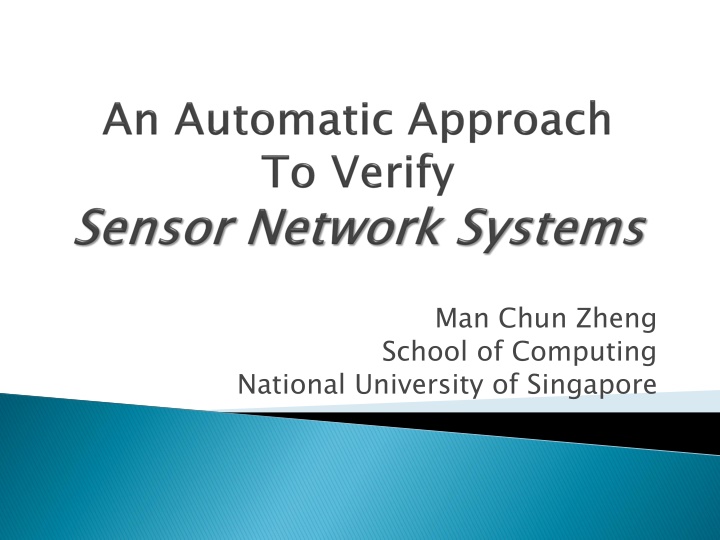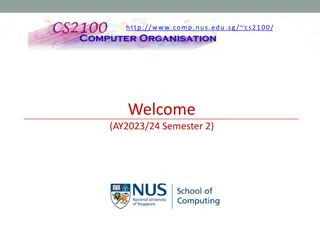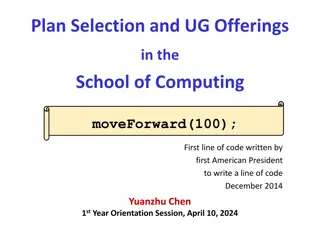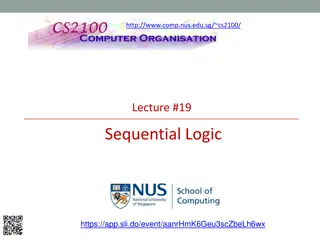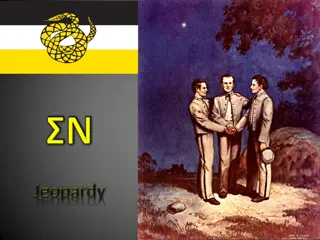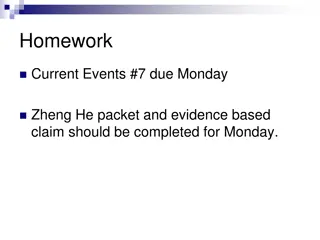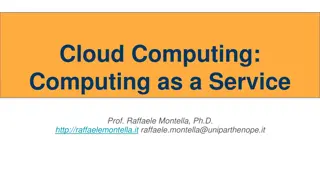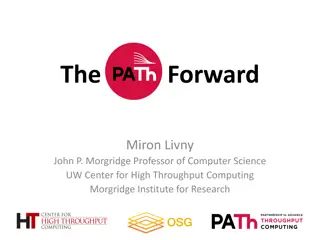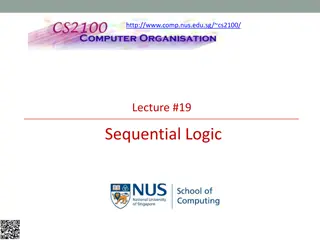Man Chun Zheng School of Computing at NUS
Located at the National University of Singapore, the Man Chun Zheng School of Computing is a reputed academic institution that offers a wide range of computer science programs. With a focus on innovation and research, the school provides students with a comprehensive education in computing, preparing them for successful careers in the tech industry. The school is known for its world-class faculty, cutting-edge facilities, and vibrant student community. Whether you are interested in artificial intelligence, data science, cybersecurity, or software engineering, the Man Chun Zheng School of Computing has something to offer for aspiring computer scientists.
Download Presentation

Please find below an Image/Link to download the presentation.
The content on the website is provided AS IS for your information and personal use only. It may not be sold, licensed, or shared on other websites without obtaining consent from the author.If you encounter any issues during the download, it is possible that the publisher has removed the file from their server.
You are allowed to download the files provided on this website for personal or commercial use, subject to the condition that they are used lawfully. All files are the property of their respective owners.
The content on the website is provided AS IS for your information and personal use only. It may not be sold, licensed, or shared on other websites without obtaining consent from the author.
E N D
Presentation Transcript
Man Chun Zheng School of Computing National University of Singapore
Introduction Background & Motivation Related Works Formal verification of TinyOS/nesC apps Methodology A Lightweight framework for verifying SN apps Experiment & Discussion Conclusion Contributions & Limitations Future work 2
Introduction Background & Motivation Related Works Methodology Experiment & Discussion Conclusion 3
Sensor Networks [1] Limited physical memory (<1 mb) Constrained power supply High concurrency TinyOS [2] Small size (<400 kb) Component-based programming model Implemented by nesC [2] 4
Correctness & Reliability of SN A SN system could be Autonomous system (e.g. Home automation ) Safety-critical system (e.g. Forest fire detection) Concurrent system Undesirable things: Design errors Frequent failures Testing and Simulation (TOSSIM) Still not sufficient: Unknown bugs Model checking -- a better solution (gurantee) 5
Model Checking Approach Construct a formal model Prove by exhaustively exploring the state space Pros Detect errors/bugs thoroughly Increase correctness & reliability Cons Construction of formal model manually is Expensive State space explosion problem is Common 6
TinyOS/nesC Mainstream sensor operating system Correctness & Reliability Formal verification -- Model Checking Low-cost verification Automatic generation of formal models Our work Lightweight approach for automatically verifying TinyOS/nesC apps 7
Introduction Related Works Formal verification of TinyOS/nesC apps Methodology Experiment & Discussion Conclusion 8
Formal Method LOTOS [4] Formal Method Approach Approach Automation Automation Model Checker Model Checker NA -Formalizing nesC apps -Interaction of components -Interactions between components -TinyOS scheduling & preemption -Extracts model from protocol impl. -Generate intrusion model -Node model extracted from nesC -Nodes connected by BIP connectors Manual CSP [5] Manual FDR ProMela [8] Automatic (SLEDE [6, 7]) Automatic SPIN BIP [9] HyTech /IF 9
Formal Method LOTOS [4] Formal Method Approach Approach Automation Automation Model Checker Model Checker NA -Formalizing nesC apps -Interaction of components -Interactions between components -TinyOS scheduling & preemption -Extracts model from protocol impl. -Generate intrusion model -Node model extracted from nesC -Nodes connected by BIP connectors Manual CSP [5] Manual FDR ProMela [8] Automatic (SLEDE [6, 7]) Automatic SPIN BIP [9] HyTech /IF 10
Formal Method LOTOS [4] Formal Method Approach Approach Automation Automation Model Checker Model Checker NA -Formalizing nesC apps -Interaction of components -Interactions between components -TinyOS scheduling & preemption -Extracts model from protocol impl. -Generate intrusion model -Node model extracted from nesC -Nodes connected by BIP connectors Manual CSP [5] Manual FDR ProMela [8] Automatic (SLEDE [6, 7]) Automatic SPIN BIP [9] HyTech /IF 11
Formal Method LOTOS [4] Formal Method Approach Approach Automation Automation Model Checker Model Checker NA -Formalizing nesC apps -Interaction of components -Interactions between components -TinyOS scheduling & preemption -Extracts model from protocol impl. -Generate intrusion model -Node model extracted from nesC -Nodes connected by BIP connectors Manual CSP [5] Manual FDR ProMela [8] Automatic (SLEDE [6, 7]) Automatic SPIN BIP [9] HyTech /IF 12
Formal Method LOTOS [4] Formal Method Approach Approach Automation Automation Model Checker Model Checker NA -Formalizing nesC apps -Interaction of components -Interactions between components -TinyOS scheduling & preemption -Extracts model from protocol impl. -Generate intrusion model -Node model extracted from nesC -Nodes connected by BIP connectors Manual CSP [5] Manual FDR ProMela [8] Automatic (SLEDE [6, 7]) Automatic SPIN BIP [9] HyTech /IF 13
Summary Most require manual construction of models Most not consider timed aspects None implements a domain-specific verifier None has formal definitions for TinyOS/nesC 14
Introduction Related Works Methodology A Lightweight framework for verifying SN apps Formally defining TinyOS/nesC nesC to RTS translation rules Verification of nesC Apps Experiment & Discussion Conclusion 15
Two levels of scheduler: task & interrupt handler Task: deferred computation Interrupt handler: event 16
Task Scheduler Task: deferred computation, run to completion, no preemption between each other. 17
Interrupt handler Scheduler Interrupt Handler: later ones preempt previous ones, preempt tasks, run-to-completion. 18
nesC[2] concepts: interface & component Interface: declares commands & events Component Module: provides/uses interfaces, Configuration: provides/uses interfaces, RTS[3]: a version of CSP with real-time extensions Global variables, channels, complex data structure Process algebra: event prefix, parallel, interleave ... Timed operations: Wait, timeout, interrupt, Supported by PAT[3]: simulation & verification. implements commands/events. wires components to one another. 19
Between nesC & RTS nesC app Concurrent nesC app RTS characteristics Successful for concurrent systems Event-based formalism Hierarchy of processes RTS characteristics Event-driven Hierarchy of components Wiring components with bi-directional interfaces Processes communicate via channels, common events, shared variables, etc 21
Translation Rule 1: interface constants identifying commands/events interface interface intf intf RTS constant RTS constant command cmd1 command cmd2 ... event evt1 event evt2 ... #define intf_cmd1 1; #define intf_cmd2 2; ... #define intf_evt1 1; #define intf_evt2 2; ... 22
Translation Rule 2a: module: interface, command/event implementation, task, local variables, etc. 23
Translation Rule 2b: command, event, task implementations. nesC (comp) intf.cmd nesC impl impl. . RTS structure comp_intf_cmd = comp_intf_C?idcmd CMD comp_intf_cmd; comp_intf_evnt = comp_intf_E?idevnt EVNT comp_intf_evnt; tsk = sdl?tskid RunTask sdl !EOT Tsk; RTS structure (comp) intf.evnt (comp) tsk 24
Translation Rule 3: configuration: wiring components, =. Wiring user.intf1 prov.intf2 or prov.intf2 user.intf1 EventSignal = prov_intf2_E?x user_intf1_E!x EventSignal; conf.intf1 = comp.intf2 CommandCall = conf_intf1_C?x comp_intf2_C!x CommandCall; EventSignal = conf_intf1_E?x -> comp_intf2_E!x EventSignal; Wiring RTS process Wire = CommandCall ||| EventSignal; CommandCall = user_intf1_C?x prov_intf2_C!x CommandCall; RTS process Wire = CommandCall ||| EventSignal; 25
Translation Rule 4: nesC statements Type assignment atomic block atomic{ S1; S2; } command call event signal intf.evnt( ); task post if-else while do-while for Type Statement a = E; Statement RTS Structure event{a = E;} atomic{ e1{S1} -> e2{S2} -> } comp_intf_C!constant(cmd); RTS Structure call intf.cmd( ); signal comp_intf_E!constant(evnt); post tsk(); if (B) A else C while (B) A do A while (B) for (A; B; C) D add task idtsk to Qt (task queue); IF = if (B) A else C; WHILE = if(B) A;WHILE else Skip; WHILE = A; if(B) WHILE else Skip; FOR = A; ReFor; ReFor = if(B) D; C; ReFor else Skip; 26
Translation Rule 5: task scheduler #define EOT -1; channel sdl 0; var <Queue> Qt; var idtsk; TaskSdl = if (Qt.Count()! = 0) { } getTask{idtsk = Qt.First()} sdl!idtsk sdl?EOT deTask{Qt.Dequeue()} TaskSdl 28
Translation Rule 5: task scheduler #define EOT -1; channel sdl 0; var <Queue> Qt; var idtsk; TaskSdl = if (Qt.Count()! = 0) { } getTask{idtsk = Qt.First()} sdl!idtsk sdl?EOT deTask{Qt.Dequeue()} TaskSdl Finally, the whole app: System = TaskSdl |||Comp_Sync ||| Comp_Sync ||| Comp_Async ||| ||| Comp_Async; 29
Types of Properties in PAT [16,17,18] Type Deadlockfree Type Assertion #assert System deadlockfree #assert System divergencefree #assert System divergencefree<T> #assert System reaches ledons #assert System |= [](BlinkC.Timer0.fired #assert System |= [](BlinkC.Timer0.fired (<> LedsC.Leds.led0Toggole)) #assert System refines P1 Assertion Property The system is deadlock free. The system is divergence free. The system is timed divergence free. Property Divergence Freeness Reachability The system reaches the state ledons. Timer0 is fired infinitely often. Temporal Properties led0 should eventually be toggled whenever Timer0 is fired. The traces of the system is a subset of those of P1. The timed traces of the system is a subset of those of P2. Refinement #assert System refines<T> P2 30
Introduction Related Works Methodology Experiment & Discussion Conclusion 32
System BlinkTask (1 timer, 1 led) System Assertion P1 P2 P3 P1 P2 P3 Assertion Result True True True True True True Result States 397 1,926 1,875 158,668 1,397,580 1,238,588 States Time(s) 0.18 0.50 0.55 78.27 1,420.72 1,039.30 Time(s) BlinkTask (3 timers, 3 leds) P1: #assert System deadlockfree; P2: []<> BlinkC.Timer.fired; P3: [] (BlinkC.Timer.fired (<> LedsC.Leds.led0Toggle)); 34
Lack of formal description of nesC or TinyOS Ongoing solution: Define operational semantics of nesC (Sec. 3-A) Define RTS semantics of TinyOS/nesC (Sec. 3-A) Prove the bi-simulation between the above 35
Introduction Related Works Methodology Experiment & Discussion Conclusion Contributions & Limitations Future work 36
Contributions Verifying TinyOS apps for many properties Automatically extracted RTS models from nesC code Model generation & verification in one framework Formal definitions of TinyOS/nesC Limitations Some syntax of nesC not supported Weak scalability Only model individual nodes 37
Completeness: develop full nesC-syntax supports Multiple wiring, struct, pointer, etc. Optimization: fix state space explosion problem Make translation rules abstract - smaller Develop more efficient verification techniques -- faster Further -- Direct verification Translation-based: usually tedious, need to prove Need to define operational semantics of nesC Model the whole network Interaction between nodes and environments Probabilistic model checking (e.g. msg loss) 38
[1] J. Hill, R. Szewczyk, A.W. an S. Hollar, D. Culler, and K. Pister, System architecture directions for networked sensors, in PLOS 00, 2000, pp. 93 104. [2] D. Gay, P. Levis, R. v. Behren, M. Welsh, E. Brewer, and D. Culler, The nesC language: a holistic approach to networked embedded systems, in PLDI 03, 2003, pp. 1 11. [3] J. Sun, Y. Liu, J. S. Dong, and H. H. Wang, Verifying stateful timed CSP using implicit clocks and zone abstraction, in ICFEM 09, 2009. [4] N. S. Rosa and P. R. F. Cunha, Behavioural specification of wireless sensor network applications, in GIIS 07, 2007, pp. 66 72. [5] A. I. McInnes, Using CSP to model and analyze TinyOS applications, in IEEE ECBS 09, 2009, pp. 79 88. [6] Y. Hanna and H. Rajan, Slede: framework for automatic verification of sensor network security protocol implementations, in ICSE Companion 09, 2009, pp. 427 428. [7] Y. Hanna, H. Rajan, and W. Zhang, Slede: a domain-specific verification framework for sensor network security protocol implementations, in WISEC 08, 2008, pp. 109 118. [8] G. J. Holzmann, Software model checking with SPIN, Advances in Computers, pp. 78 109, 2005. 39
[9] A. Basu, L. Mounier, M. Poulhi`es, J. Pulou, and J. Sifakis, Using BIP for modeling and verification of networked systems a Case study on TinyOS- based networks, in NCA 07, 2007, pp. 257 260. [10] J. Sun, Y. Liu, J. S. Dong, and J. Pang, PAT: towards flexible verification under fairness, in CAV, 2009, pp. 709 714. [11] J. Sun, Y. Liu, J. S. Dong, and H. H. Wang, Specifying and verifying event- based fairness enhanced systems, in ICFEM, 2008, pp. 5 24. [12] B. P. Mahony and J. S. Dong, Timed communicating Object Z, IEEE Trans. Software Eng., vol. 26, no. 2, pp. 150 177, 2000. [13] , Blending Object-Z and Timed CSP: an introduction to TCOZ, in ICSE, 1998, pp. 95 104. [14] PAT website, http://www.comp.nus.edu.sg/ pat/. [15] J. Sun, Y. Liu, J. S. Dong, and J. Sun, Bounded model checking of compositional processes, in TASE 08, 2008, pp. 23 30. [16] Y. Liu, W. Chen, Y. A. Liu, and J. Sun, Model checking linearizability via refinement, in FM 09, 2009, pp. 321 337. 40
The End Thank You! 41
